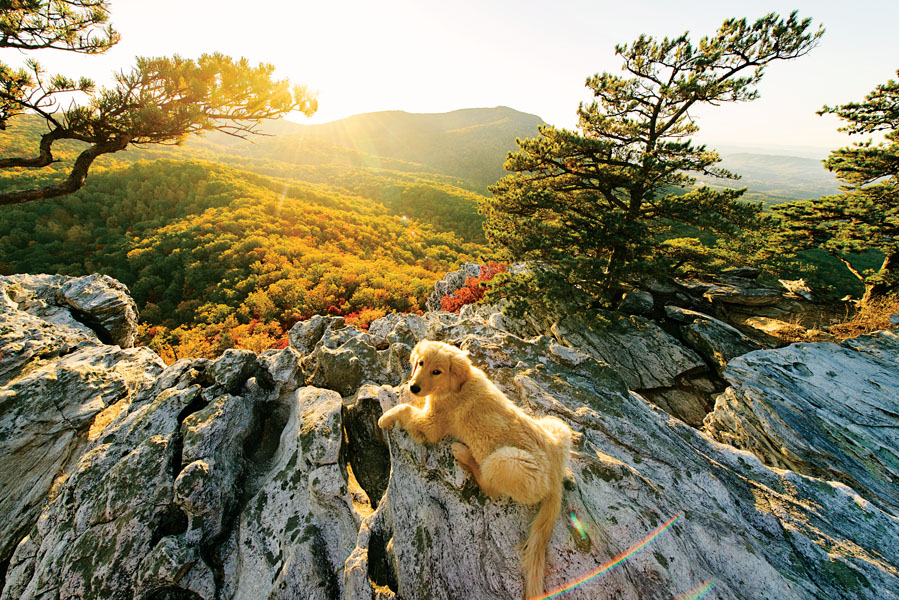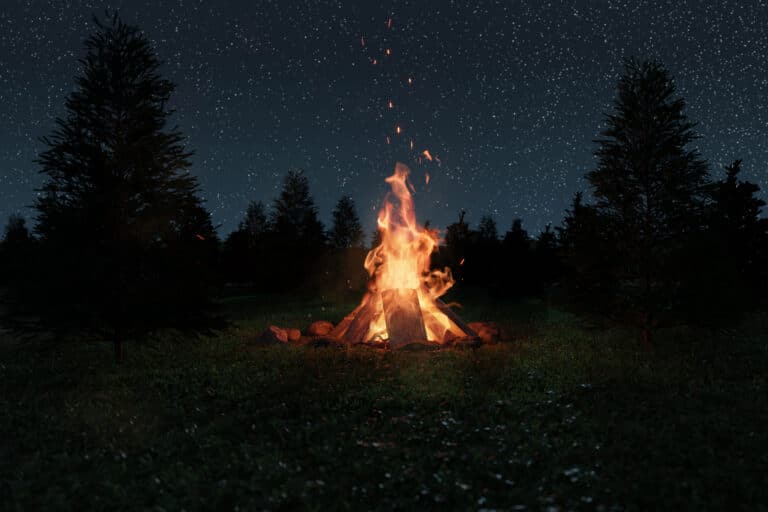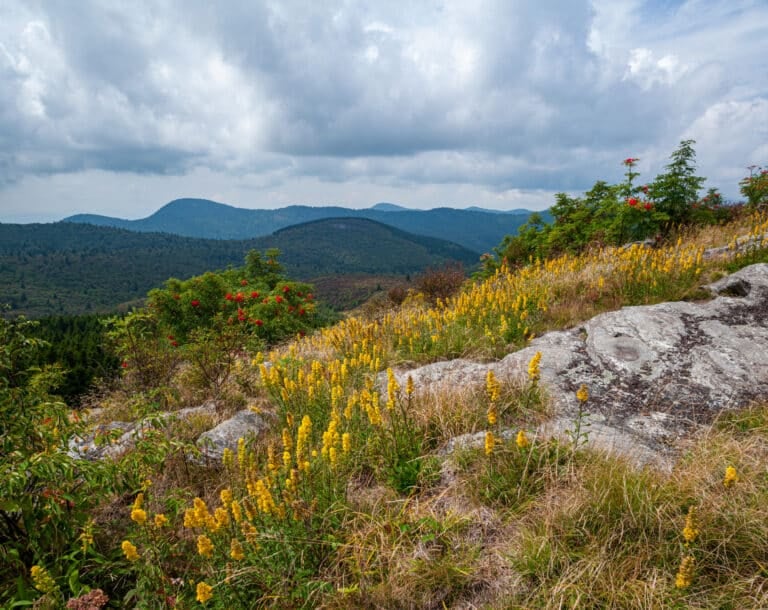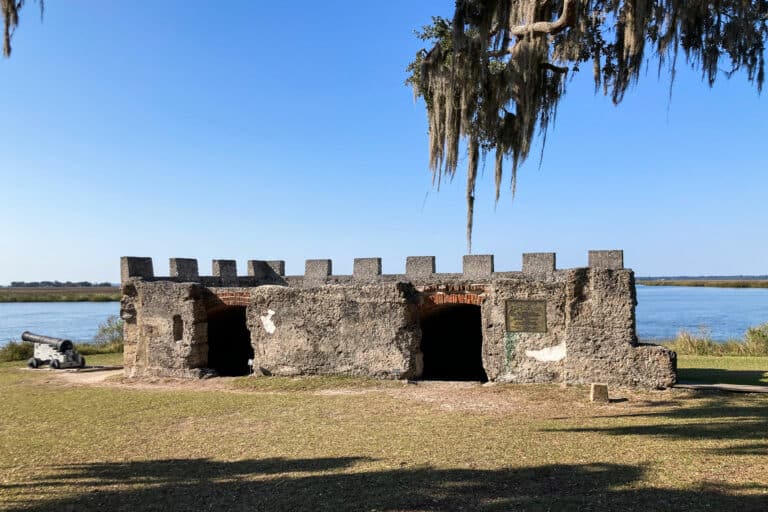Autumn can be a great time to get outdoors, but the change in season brings more than those beloved golden-red vistas. If you’re sick of the leaf peepin’ crowds, we’ve consulted some regional hiking experts for 10 hikes less traveled, rated on a solitude scale of 0 to 5 (0 = crowded; 5 = not a soul in sight), so you can still hit the trail and soak in the colors without competing with the masses.
Opossum Creek Falls, South Carolina
Distance: 4.6 miles
Difficulty: Moderate
TYPE: Out-and-back
What this often-disregarded day hike lacks in mileage, it makes up for two-fold in its splendor. Hikers will have a relatively easy start from the trailhead, which leads downhill to the banks of the Chattooga Wild and Scenic River corridor. You could pause here—short of whitewater, the Chattooga is renowned for its diverse flora and fauna as well as fishing holes—but it gets better. Head left and start climbing beneath the golden hardwood canopy. In two miles, you’ll reach the 50-foot falls, which cascade over a series of drops. The flow varies throughout the year, but it’s always sure to be brisk. Dip your toes, splash your face, and revel in its glory. If you hang out long enough, you’re likely to spot a black bear or wild turkey.
Solitude Rating: 4/5
“This hike is often overlooked, as it is not connected to other trails in the greater Chattooga River trail systems.” —Johnny Molloy, Guidebook Author
Gahuti Trail, Georgia
Distance: 8.2 miles
Difficulty: Moderate
Type: Loop
The word ‘Gahuti’ is Cherokee for ‘mother mountain,’ and hardly 10 minutes from the parking lot in Fort Mountain State Park, you’ll see the name was justly given. The Gahuti rolls steadily along the crest of Fort Mountain, taking hikers through a variety of terrain from high and dry ridgelines dotted with glowing oak trees to the down low mossy creekbeds shaded in rhododendron. Trails up high lead to rocky outcroppings featuring postcard-worthy views of Georgia’s southern Appalachian mountains. Though it adds two additional miles to the hike, we strongly suggest hopping onto the red-blazed Overlook and Tower Trail, a quick out-and-back side trail that leads to even more astounding views.
Solitude Rating: 3/5
“There’s a lot of national forest land around [the Gahuti], and people don’t think about having a wilderness experience in a state park but you can.” —Johnny Molloy, Guidebook Author
Florence Nature Preserve, North Carolina
Distance: 5.3 miles
Difficulty: Moderate
Type: Loop
This 600-acre parcel of protected land on the southern slope of Little Pisgah Mountain is a place of regional history, natural beauty, and rugged trails. In decades past, the land saw a handful of subsistence farmers and served as an important stopping point for travelers headed west to Asheville along the Old Buncombe Turnpike. Now, hikers can fully immerse themselves in the magic of this place by way of a trail network that will soon be complete. Go back in time as you saunter beneath the limbs of old-growth forest and past log cabin ruins. No visit here is complete without making the trek to Rattlesnake Knob for its picturesque scenery.
Solitude Rating: 4/5
“It’s just forgotten, overshadowed by many other destinations in the Asheville/Hendersonville area. Most people go west or toward the main crest of the Appalachians but here you have to go a little east. I’d never heard of it myself till I started writing a guidebook for the Asheville area.” —Johnny Molloy, Guidebook Author
Bartram Trail, North Carolina
Distance: 5.4 miles
Difficulty: Moderate
Type: Out-and-back
Peak baggers will find this hike relatively tame for a day trip, though for the stunning sights atop Jones Knob and Whiterock Mountain, the solitude you can expect here will seem downright sacrilege. Popular during the spring and summertime for its wildflowers, most people who do end up on the Bartram only make the trek to Wayah Bald, and rightfully so. The 360-degree marvels up here are truly humbling—you can see nearly all of Macon County’s nineteen 5,000-foot peaks from here, which is what makes it such a popular tourist spot. But if it’s seclusion you’re after, crank up Jones Knob and you’ll be sure to never see a soul. At 4,622 feet (Jones Knob) and 4,480 feet (Whiterock), these two peaks are among the top three highest summits on section two of the Bartram Trail. Bring a picnic for the trip—the exposed granite rock cliffs here, especially on Whiterock, rival rock you’d see over in Cashiers or Highlands, N.C., and make a great place to post up and revel in the grandeur of nature.
Solitude Rating: 4.5/5
“If you do see people, they’re going to be locals. Most people that are even going to get on the Bartram have to accept a moderate to strenuous hike. There’s not easy hiking anywhere.”
—Rob Gasbarro, Co-Owner Outdoor 76, Franklin, N.C.
Chunky Gal Trail, North Carolina
Distance: 8 miles
Difficulty: Strenuous
Type: Out-and-back
Situated near the border of North Carolina and Georgia in the southern Nantahalas, the 22-mile Chunky Gal Trail is remote and often overgrown, despite its consistent trail markings (look for the blue blaze). Not far from Franklin, N.C., this trail is often overshadowed by its famed white blaze sister, the Appalachian Trail, which intersects with Chunky Gal just past Muskrat Creek Shelter. Park at Bob Allison Campground and set off on the steady 3.5-mile climb to the summit of Tusquitee Bald. At 5,240 feet, this panoramic bald will be sure to keep the inexperienced crowds at bay. You can also loop up the Chunky Gal with the Appalachian Trail for a little sprinkling of solitude with plenty of that trail community we all hold near and dear. Keep your eyes peeled for old-growth hemlocks in this area. They won’t be changing color, obviously, but their impressive stature is sure to drop your jaw.
Solitude Rating: 4/5
“The Appalachian Trail is so great and so iconic and in a lot of ways it distracts from other trails that are equally beautiful or very similar in terrain and I think the Chunky Gal is one of those trails. Because it’s not the A.T. it’s less traveled and more remote.” —Jennifer Pharr Davis, Owner, Blue Ridge Hiking Company, Asheville, N.C.
Big Frog Wilderness, Tennessee
Distance: 11 miles
Difficulty: Strenuous
Type: Out-and-back
The trails in Tennessee’s Big Frog Wilderness are rough, unsigned, and little maintained, but that’s what we love about this wild area. Combined with Georgia’s neighboring Cohutta Wilderness, these two public lands form the largest unbroken wilderness in the southern Appalachians. Starting at Low Gap, you’ll climb to the top of Big Frog Mountain, where overlooks, campsites, and creek dips await. You can certainly bust out this long hike in a day, but why rush it? There is plenty of exploring to do here, and you can even loop Big Frog with the Benton MacKaye trail for a slightly longer 13-mile hike. Peep between the tree trunks as you walk—there are plenty of rock clusters that make for a quiet oasis where you can bask in the views of the Chattahoochee National Forest. The trail will certainly give you radiant displays of fall colors, but it will also lead you through rhododendron tunnels and pine forests that speckle the otherwise golden-red canopy in patches of evergreen.
Solitude Rating: 4.5/5
“Big Frog’s best feature is its wilderness character. There are good views, but not great views, and that’s what actually keeps this trail lesser visited.” —Johnny Molloy, Guidebook Author
Flat Peter/Dixon Branch Loop, Virginia
Distance: 8.7 miles
Difficulty: Strenuous
Type: Loop
Though the word “flat” appears in the name of this hike, don’t let it fool you—this is a rigorous loop meant only for experienced backpackers. The circuit climbs through Virginia’s Mountain Lake Wilderness and passes through the western end of Peters Mountain Wilderness. The trails are occasionally marked, albeit faintly, and there are large portions of the loop that require basic route-finding skills. It’s no wonder that this hike ranks high on our solitude scale, but navigational difficulty aside, it’ll be easy to see why we consider this loop a must-do—golden meadows interlaced with wetlands, rocky ridges and outcroppings pockmarked by dark green rhododendron thickets and hip-high ferns. This hike has it all, especially for those willing to work hard for a little one-on-one time with Mother Nature. Make note to revisit this special place in the summer—you can find ample huckleberry bushes atop Huckleberry Ridge, which you’ll circle before passing through Peters Mountain Wilderness.
Solitude Rating: 5/5
“It’s badly mapped, there’s poor information, kinda an obscure trailhead, and all of that conspires to leave it to the intrepid explorers. Once you get on it, it ain’t easy to follow, but it’s really cool.” —Johnny Molloy, Guidebook Author
Laurel Fork Wilderness—North, West Virginia
Distance: 8.6 miles
Difficulty: Easy
Type: Out-and-back
For the adventurous amateur or family crew, this one’s for you. Nestled in the Greenbrier Ranger District of West Virginia’s Monongahela National Forest, the Laurel Fork Wilderness is about as quiet as it gets. Literally. Don’t expect any cell service out here. Within the wilderness area’s 11,839 acres (6,055 of which are in the northern section), one can climb anywhere from 2,900 feet to over 3,700 feet. You’ll mostly be sticking to the lower elevations on this one. There are 9.5 miles of trails to explore in the northern wilderness, and most of these trails follow old roadbeds and railroad grades. As you amble along the Laurel Fork River Trail, admiring the towering canopy along the river’s edge, consider that at one point in time, this entire area was logged. It may shed a new, more appreciative light on this now-untamed pocket of West Virginia.
Solitude Rating: 5/5
“Unless you’re a fisherman or a solitude seeker, and really there aren’t even that many fishermen, this area doesn’t have a comprehensive trail network. It’s one of those places where every step, you just enjoy it.”
—Johnny Molloy, Guidebook Author
Allegheny Trail, West Virginia
Distance: 10 miles
Difficulty: Easy
Type: One way
Running for 330 miles from the Pennsylvania-West Virginia border to Peters Mountain in eastern West Virginia, the Allegheny Trail is the state’s only long-distance hiking and biking trail and is unique in its combination of private and public lands. There are still 30 miles of the trail that are incomplete, but when it’s finished, this removed trail will take visitors past three state parks, four state forests, two national wilderness areas, and three national forests. Begin this one-way, family friendly hike in Albright, W.Va., near the Cheat River Festival site. You’ll be tracing and crisscrossing the banks of the Cheat River until you reach the take out at Jenkinsburg Bridge (set shuttle or stop halfway and walk back to your car). Along the way, expect to develop a personal acquaintance with the Cheat River Basin’s abundant life—bobcats, otters, bald eagles, and the flat-spired three-toothed snail are just a few of the many species that call the Cheat home. About halfway, you’ll want to stop and take a break at High Falls. Here, the river funnels into a near river-wide wave. Watch passing kayakers surf against a backdrop of vibrant reds, oranges, and yellows.
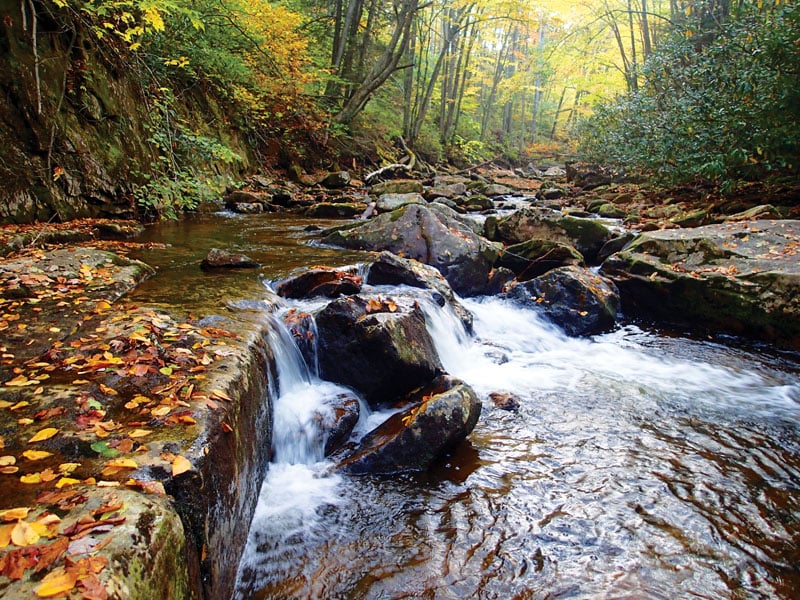
Solitude Rating: 5/5
“The entire canyon is a remarkable, completely wild and wonderful, remote Appalachia river canyon. The road access to the lower end of the trail can be questionable for non 4×4 vehicles, though plenty of two-wheel drive vehicles make it down there.” —Gabe DeWitt, Outdoor Lifestyle Photographer, Morgantown, W.Va.
Laurel Highlands Trail, Pennsylvania
Distance: 70 miles
Difficulty: Strenuous
Type: One-way, six-day overnighter
Looming hardwoods, carpets of ferns, wild mushrooms, massive rock outcroppings, salamanders, lakes, cascades. No matter the time of the year, the Laurel Highlands Trail provides a hefty dose of natural majesty. If you only have time for a day trip, try hiking north from the trail’s southern terminus in Ohiopyle, though you more than likely won’t be alone. The views of the winding Youghiogheny River in fall are like a painting, but also relatively accessible. The farther in you hike, the more isolation you’ll find. There are plenty of shelters along the trail (conveniently situated every eight to 10 miles), so you can pack light and focus on the miles. One of our favorite stopping points is at mile 11, where you’ll encounter a perfectly still lake. During peak colors, the lake practically glows from the warm shades reflected on the water’s surface. If you’re planning to hike the trail in its entirety, Wilderness Voyageurs in Ohiopyle offers shuttles for hikers.
Solitude Rating: 4/5
“The southern end of the LHHT is the more difficult section, with a couple of climbs and descents into the Yough Gorge. This also makes for some of the best scenery, peeking into the gorge and crossing beautiful little creeks. Late fall hikers should keep an eye on bear hunting season in Pennsylvania and wear blaze orange.” —Eric Martin, Owner, Wilderness Voyageurs
How to Avoid Tourists
When you rack up 13,000+ miles of hiking on some of the most remote trails in the world, learning to enjoy your own company is par for the course. Former Appalachian Trail record holder Jennifer Pharr Davis is, among many other things, a wife, a business owner, a hiking guide, and a soon-to-be mother of two. Now, more than ever, when Pharr Davis hits the trail, solitude is what she seeks. Check out some of her tips for escaping the leaf peeping masses, and staying safe.
Avoid peak season.
Or, more precisely, avoid “peak season” as most tourists define it—October. “October is our busiest month, but then the first weekend of November, everything drops off. A lot of times, the first weekend of November is gorgeous! The last week of September is also a great time to hike, especially if you can get up into the Mid-Atlantic where the leaves may have already changed.” Similarly, Pharr Davis suggests going farther south (say, the Pinhoti Trail in Georgia) later in the season, which will have just as much color without the people.
Go during the weekdays.
We call these “personal health” days.
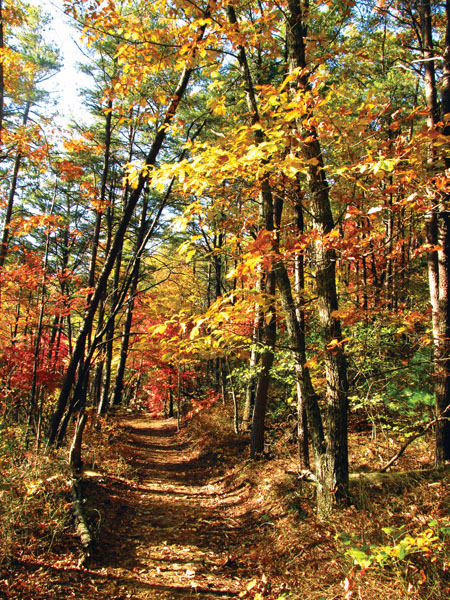
BRAVE the elements.
The harsher the weather, the more of a reason for out-of-towners to stay put in their hotel rooms. “You can be on a super popular trail, like the A.T., and if there’s a 70 percent chance of rain, there’s no one out there and it’s amazing to see the trail in all types of weather. Some of my most memorable moments on the trail have been during a rain or snowstorm when the clouds break. The great part about fall hiking is you don’t even need the views. If it’s boxed in or there’s cloud cover you still get to see all of the colors of the forest and you almost appreciate the details more. There’s a real advantage to going when there’s not perfect sunny weather.”
Hike till dark.
If you want to ensure that your campsite is secluded, don’t set up your tent early, Pharr Davis says. And try targeting national forests and public spaces where camping isn’t strictly regulated, forcing you to be tent flap to tent flap with your fellow outdoorsmen and women. “I like to have a long break in the afternoon or stop to cook dinner and then hike until 7 or 7:30. If you wait until then, you can feel pretty confident that if you set up your tent, you’re going to be the only person there through the night.”
Pack your patience.
Do your research, bring maps, ask locals for beta, but also, remember to be flexible. “If you’re going out and looking for solitude, and going to a trail less traveled to find it, don’t be frustrated when it’s overgrown or not as well-marked as a greenway or the A.T., because that’s part of the compromise of solitude.”
Be responsible.
Being alone means being aware. “Have the right gear and navigational tools. If you’re looking for solitude and something happens, there’s a good chance no one else is going down the trail in the next few hours or the next few days. Leaving an itinerary and general description of where you’re hiking with someone at home is important.”
Know when the next football game will air.
This is the South. Football is big stuff around here. Use it to your advantage. “When there’s a big SEC game, like Alabama vs. Georgia, that’s when you go hike.”
Related:
